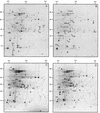Novel two-component regulatory system involved in biofilm formation and acid resistance in Streptococcus mutans
- PMID: 12399503
- PMCID: PMC151940
- DOI: 10.1128/JB.184.22.6333-6342.2002
Novel two-component regulatory system involved in biofilm formation and acid resistance in Streptococcus mutans
Abstract
The abilities of Streptococcus mutans to form biofilms and to survive acidic pH are regarded as two important virulence determinants in the pathogenesis of dental caries. Environmental stimuli are thought to regulate the expression of several genes associated with virulence factors through the activity of two-component signal transduction systems. Yet, little is known of the involvement of these systems in the physiology and pathogenicity of S. mutans. In this study, we describe a two-component regulatory system and its involvement in biofilm formation and acid resistance in S. mutans. By searching the S. mutans genome database with tblastn with the HK03 and RR03 protein sequences from S. pneumoniae as queries, we identified two genes, designated hk11 and rr11, that encode a putative histidine kinase and its cognate response regulator. To gain insight into their function, a PCR-mediated allelic-exchange mutagenesis strategy was used to create the hk11 (Em(r)) and rr11 (Em(r)) deletion mutants from S. mutans wild-type NG8 named SMHK11 and SMRR11, respectively. The mutants were examined for their growth rates, genetic competence, ability to form biofilms, and resistance to low-pH challenge. The results showed that deletion of hk11 or rr11 resulted in defects in biofilm formation and resistance to acidic pH. Both mutants formed biofilms with reduced biomass (50 to 70% of the density of the parent strain). Scanning electron microscopy revealed that the biofilms formed by the mutants had sponge-like architecture with what appeared to be large gaps that resembled water channel-like structures. The mutant biofilms were composed of longer chains of cells than those of the parent biofilm. Deletion of hk11 also resulted in greatly diminished resistance to low pH, although we did not observe the same effect when rr11 was deleted. Genetic competence was not affected in either mutant. The results suggested that the gene product of hk11 in S. mutans might act as a pH sensor that could cross talk with one or more response regulators. We conclude that the two-component signal transduction system encoded by hk11 and rr11 represents a new regulatory system involved in biofilm formation and acid resistance in S. mutans.
Figures







Similar articles
-
Additive attenuation of virulence and cariogenic potential of Streptococcus mutans by simultaneous inactivation of the ComCDE quorum-sensing system and HK/RR11 two-component regulatory system.Microbiology (Reading). 2008 Nov;154(Pt 11):3256-3265. doi: 10.1099/mic.0.2008/019455-0. Microbiology (Reading). 2008. PMID: 18957580
-
Involvement of Streptococcus mutans regulator RR11 in oxidative stress response during biofilm growth and in the development of genetic competence.Lett Appl Microbiol. 2008 Nov;47(5):439-44. doi: 10.1111/j.1472-765X.2008.02455.x. Lett Appl Microbiol. 2008. PMID: 19146535 Free PMC article.
-
A quorum-sensing signaling system essential for genetic competence in Streptococcus mutans is involved in biofilm formation.J Bacteriol. 2002 May;184(10):2699-708. doi: 10.1128/JB.184.10.2699-2708.2002. J Bacteriol. 2002. PMID: 11976299 Free PMC article.
-
Quorum sensing and biofilm formation by Streptococcus mutans.Adv Exp Med Biol. 2008;631:178-88. doi: 10.1007/978-0-387-78885-2_12. Adv Exp Med Biol. 2008. PMID: 18792689 Review.
-
The VicRK Two-Component System Regulates Streptococcus mutans Virulence.Curr Issues Mol Biol. 2019;32:167-200. doi: 10.21775/cimb.032.167. Epub 2019 Jun 5. Curr Issues Mol Biol. 2019. PMID: 31166172 Review.
Cited by
-
Beyond Antibiotics: What the Future Holds.Antibiotics (Basel). 2024 Sep 25;13(10):919. doi: 10.3390/antibiotics13100919. Antibiotics (Basel). 2024. PMID: 39452186 Free PMC article. Review.
-
PBP1a-deficiency causes major defects in cell division, growth and biofilm formation by Streptococcus mutans.PLoS One. 2015 Apr 16;10(4):e0124319. doi: 10.1371/journal.pone.0124319. eCollection 2015. PLoS One. 2015. PMID: 25880908 Free PMC article.
-
Multilevel control of competence development and stress tolerance in Streptococcus mutans UA159.Infect Immun. 2006 Mar;74(3):1631-42. doi: 10.1128/IAI.74.3.1631-1642.2006. Infect Immun. 2006. PMID: 16495534 Free PMC article.
-
Adaptive acid tolerance response of Streptococcus sobrinus.J Bacteriol. 2004 Oct;186(19):6383-90. doi: 10.1128/JB.186.19.6383-6390.2004. J Bacteriol. 2004. PMID: 15375118 Free PMC article.
-
Effect of an orphan response regulator on Streptococcus mutans sucrose-dependent adherence and cariogenesis.Infect Immun. 2003 Aug;71(8):4351-60. doi: 10.1128/IAI.71.8.4351-4360.2003. Infect Immun. 2003. PMID: 12874312 Free PMC article.
References
-
- Bhagwat, S. P., J. Nary, and R. A. Burne. 2001. Effects of mutating putative two-component systems on biofilm formation by Streptococcus mutans UA159. FEMS Microbiol. Lett. 205:225-230. - PubMed
-
- Claverys, J. P., A. Dintilhac, E. V. Pestova, B. Martin, and D. A. Morrison. 1995. Construction and evaluation of new drug-resistance cassettes for gene disruption mutagenesis in Streptococcus pneumoniae, using an ami test platform. Gene 164:123-128. - PubMed
Publication types
MeSH terms
Substances
Grants and funding
LinkOut - more resources
Full Text Sources
Medical

